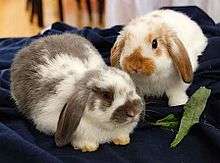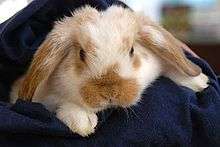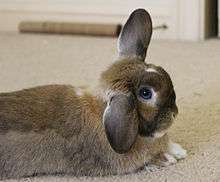Holland Lop

The Holland Lop is a breed of rabbit originating in the Netherlands. The breed was recognized by the Netherlands' Governing Rabbit Council in 1984 and the American Rabbit Breeders' Association in 1979.






Diet and Feeding
The Holland Lop rabbit should be fed daily with good quality pellets, fresh vegetables, and unlimited grass or timothy hay, as well as fresh water. Pellets should be fed one ounce per pound of body weight. Rabbits enjoy many different types of fresh vegetables, such as romaine lettuce, endives, parsley, coriander, dill, fennel and arugula, as well as carrots. Fresh leafy vegetables should be fed at a rate of at least 1 packed cup per 2 pounds of body a day. Leafy greens high in oxalic acid, such as parsley and spinach, should not be fed every day. Non-leafy vegetables such as carrots or peppers should be fed in much smaller quantities, about 1 tablespoon per 2 pound of body weight per day.[1] Alfalfa hay or alfalfa based pellets should only be fed to juvenile rabbits under 1 year. Treats from pet supplies stores are often not particularly safe for rabbits to ingest. They often are high in sugar or fat, or contain foods that rabbits cannot digest.[2] Avoid foods such as iceberg lettuce and celery, which contain no nutritional value, as well as corn, which can be difficult to digest.
Judging
Show quality Holland Lops should weigh between 2-4 lbs per ARBA standard. The Holland Lop is excitable by nature, and may require a light touch to pose. The Holland Lop should pose with the head held high and front feet resting lightly on the floor. The head is to be wide, round, and short, being apple-like in appearance, with a very short, well filled, muzzle and cheek. The ears are to be thick and short, and hang vertically with no ear control, approximately one finger-width from the eye. The crown should be full and wide. The body should be short, compact, and wide, with a topline starting at the head, with no dip over the shoulders, and curving to a well filled hindquarter. The hindquarter should be broad and deep, and the shoulders should be short and high, slightly less wide than the hindquarters. The animal is to be well-muscled, and a small dewlap is permitted in does. The chest should be wide, exhibiting width between the front legs. The bone in the leg should be dense and thick. The ankles should be thick and well developed. The fur should be glossy and dense, approximately one inch long, and is rollback. The fur should not be wooly, silky, or harsh. The color and markings should be correct for the variety description, and in broken animals, points should be divided evenly between color and markings. The animal is to be in good condition, not diseased, not overly thin or fat, and exhibit a healthy look.
Breed Registry
The ARBA breed registry for Holland Lop rabbits is the Holland Lop Rabbit Specialty Club (HLRSC).
Recognized Varieties
Holland Lops are recognized in a variety of colors, in several variety groups. These groups are shown in two color classifications; broken and solid. Solid rabbits are entirely one color without a white background, while brokens have patches of one or two colors on a white background.
Agouti: ~Chestnut Agouti ~Chocolate Agouti ~Chinchilla ~Chocolate Chinchilla ~Lynx ~Opal ~Squirrel
Broken: ~Broken ~Tri Colored
Pointed White: ~Pointed White (Black, Blue, Chocolate, or Lilac)
Self: ~Black ~Blue ~Chocolate ~Lilac ~White, Blue Eyed (BEW) ~White, Ruby Eyed (REW)
Shaded: ~Sable Point ~Siamese Sable ~Seal ~Smoke Pearl ~Tortoise (Black, Blue, Chocolate, or Lilac)
Tan Pattern: ~Otter (Black, Blue, Chocolate, or Lilac)
Ticked: ~Steel (Black, Blue, Chocolate, or Lilac, either Gold or Silver tipping)
Wide Band: ~Cream ~Frosty ~Orange ~Red
Breeding
Holland Lops are notoriously difficult to breed. They are slow to mature, and go through an extensive period as an older junior and younger senior known as the 'ugly stage', in which the entire rabbit seems out of proportion. They also don't have large litter sizes, averaging at 3-4, but can range from 1-7. Holland Lops are a dwarf breed, which means they possess the Dw gene. One copy of this gene makes a potentially show quality rabbit called a true dwarf, while no copies makes a false dwarf, often over the breed weight limit. Two copies of the dwarf gene is fatal, and is called a peanut. When cage-breeding rabbits, one must always take the doe to the buck's cage, because does can be territorial by nature. Each mating takes under a minute. The gestation period is 31 days, and kits stay with their mothers for seven to eight weeks. Ears start to lop anytime from four to seven weeks depending on the individual in question. This point in a Holland Lop's life is critical for socialization to make a friendly adult.
See also
References
- ↑ "Suggested Vegetables and Fruits". House Rabbit Society. Retrieved 18 January 2016.
- ↑ "Treat Foods". House Rabbit Society. Retrieved 18 January 2016.
- Fletcher, Ann (2013). "Holland Lop Rabbits The Complete Owner's Guide to Holland Lop Bunnies How to Care for your Holland Lop Pet, including Breeding, Lifespan, Colors, Health, Personality, Diet and Facts", p. 68. Evolution Knowledge Limited. ISBN 9781909820043
External links
- House Rabbit Society
- American Rabbit Breeders Association ARBA
- HLRSC
- Holland Lop Rabbit Breed History
- Breeds of Rabbits